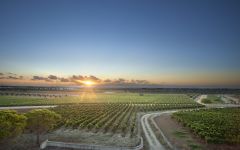Cantele Negroamaro Rosato 2014


Product Details
Your Rating
Somm Note
Winemaker Notes
Suitable for cheese souffle, soups, vegetable dishes and fish.
Other Vintages
2018-
Wine
Spectator
-
Robert
Parker





At the end of World War II, when most of the population of Puglia was moving North to work in the big factories near Torino and Milano, Giovanni Battista Cantele, a wine merchant living in the nothern city of Imola, moved his family to Salento. The final decision was made by his wife Teresa Manara, who, at the time, barely knew anything about the area but fell in love with Puglia at first sight. She would later become the inspiration for a wine that now bears her name. After studying winemaking in Conegliano, Giovanni's son, Augusto Cantele, started the family winery, Cantine Cantele, with his father and his brother Domenico in 1979. Today, Teresa Manara and Giovanni Battista Cantele’s grandchildren run the winery together: Augusto’s children, Gianni and Paolo; and Domenico’s children, Umberto and Luisa. The Cantele winery is located in Guagnano, in the heart of the DOC where Negro Amaro dominates the landscape. Situated in the heart of the Mediterranean, Puglia is a land of rare beauty, where vast plains alternate with gentle hills. Salento, the long narrow strip that forms Puglia’s southern peninsula, extends between the Ionian and Adriatic seas. It’s an area rich with ancient olive groves and vines, enchanting beaches and jagged rocky shoreline.

Whether it’s playful and fun or savory and serious, most rosé today is not your grandmother’s White Zinfandel, though that category remains strong. Pink wine has recently become quite trendy, and this time around it’s commonly quite dry. Since the pigment in red wines comes from keeping fermenting juice in contact with the grape skins for an extended period, it follows that a pink wine can be made using just a brief period of skin contact—usually just a couple of days. The resulting color depends on grape variety and winemaking style, ranging from pale salmon to deep magenta.

Thanks to the renewal of the collaboration between the Italian Trade Agency (ITA) and Wine.com, 50 new wineries and distilleries have been selected as new suppliers to the Wine.com platform. Click here to learn more about this program.
Italian Wine
Named “Oenotria” by the ancient Greeks for its abundance of grapevines, Italy has always had a culture virtually inextricable from red, white and sparkling wines. Wine grapes grow in every region throughout Italy—a long and narrow boot-shaped peninsula extending into the Mediterranean.
Italian Wine Regions
Naturally, most Italian wine regions enjoy a Mediterranean climate and a notable coastline, if not coastline on all borders, as is the case with the islands of Sicily and Sardinia. The Alps in the northern Italian wine regions of Valle d'Aosta, Lombardy and Alto Adige create favorable conditions for cool-climate grape varieties. The Apennine Mountains, extending from Liguria in the north to Calabria in the south, affect climate, grape variety and harvest periods throughout. Considering the variable terrain and conditions, it is still safe to say that most high quality viticulture in Italy takes place on picturesque hillsides.
Italian Grape Varieties
Italy boasts more indigenous grape varieties than any other country—between 500 and 800, depending on whom you ask—and most Italian wine production relies upon these native grapes. In some Italian wine regions, international varieties have worked their way in, but are declining in popularity, especially as younger growers take interest in reviving local varieties. Most important are Sangiovese, reaching its greatest potential in Tuscany, as well as Nebbiolo, the prized grape of Piedmont, producing single varietal, age-worthy Piedmontese wines. Other important varieties include Corvina, Montepulciano, Barbera, Nero d’Avola and of course the white wines, Trebbiano, Verdicchio and Garganega. The list goes on.
